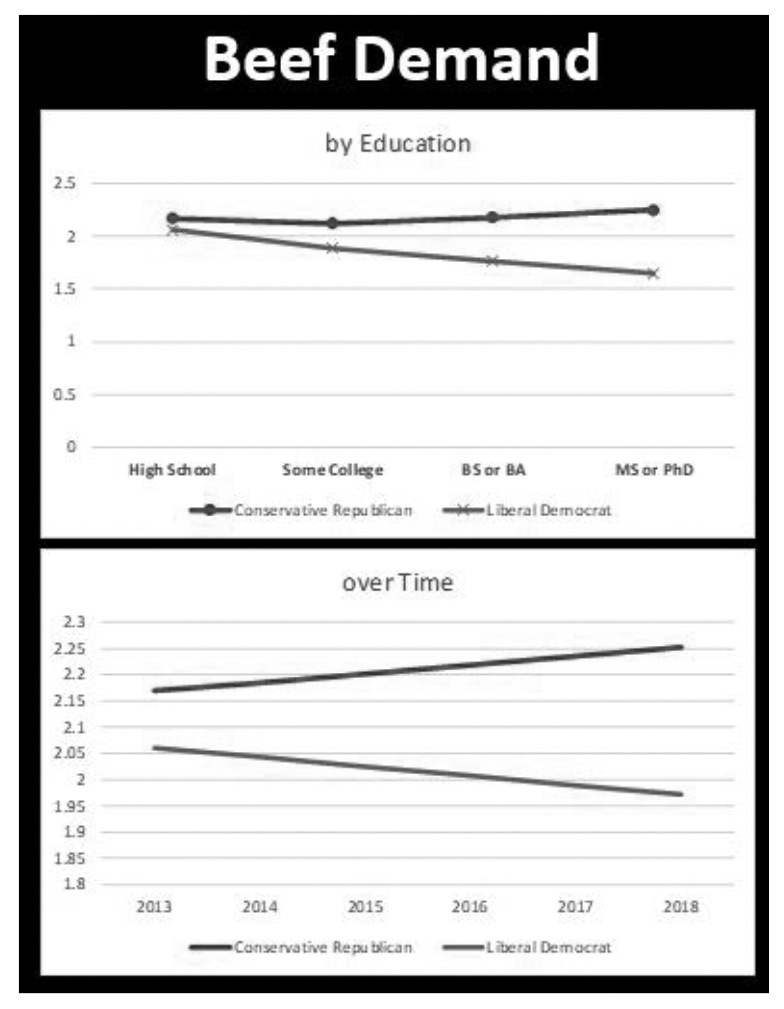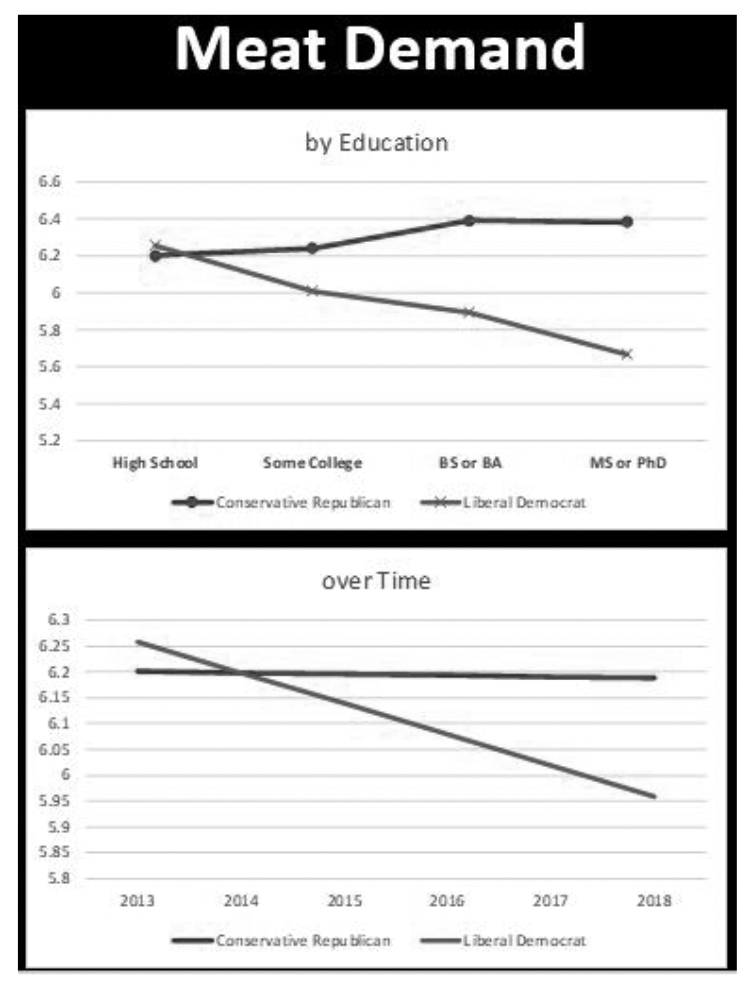
This is a venture outside the normal “technical” or “management” theme of this column, but I found the following blog by Jason Lusk, Food and Agricultural Economist, former Professor of Agricultural Economics at Oklahoma State University, and current Department Head for Agricultural Economics at Purdue University, particularly interesting within the context of how political subscription may influence beef demand in the future. I am sharing it in its entirety.
“There is growing criticism of meat production industries in popular culture and mainstream media. Examples include the recent release of the EAT-Lancet report, the World Health Organization pronouncement on red meat and cancer, the proposed Green New Deal and “farting cows,” and much more. The result is an increasing number of news stories linking beef consumption with climate change and other adverse environmental impacts. As shown in this report (co-authored by Glynn Tonsor, Ted Schroeder, and myself), the number of news stories mentioning beef and climate change increased almost 800% since the early 2000s.
Here’s the thing. We know climate change is a politically polarized issue. Might linking beef and meat consumption to a politically polarized issue in turn cause meat consumption itself to become politically polarized? As I’ve shown in previous posts (e.g., see here or here), self defined political ideology (on a scale of very liberal to very conservative) is one of the strongest predictions of whether someone says they are a vegetarian or vegan.
To investigate this issue, I turned to the body of work that referred to as the Cultural Cognition Project that is most associated with Dan Kahan at Yale. The basic idea is that individuals conform their beliefs about disputed matters of fact to values that define their cultural identities (or match their tribe). In one of the most interesting demonstrations of this concept, Kahan shows that the likelihood of agreeing with the statement “There is solid evidence of recent global warming due mostly to human activity such as burning fossil fuels” is increasing in a person’s measured scientific intelligence (essentially a score on a science quiz) but only for people who identify as liberal democrats. For people who identify as conservative republicans, higher scientific intelligence is associated with a reduced likelihood of agreeing with the above sentence. The result is that (unlike what we’d expect if “more education” was the answer), the greatest disagreements are among the most scientifically literate but of opposite political parties. One take home message from these sorts of findings is that the smarter you are, the easier it is to fool yourself.
Ok, back to meat. As readers of this blog likely know, I ran the Food Demand Survey (FooDS), which surveyed 1,000 consumers every month (different samples of consumers were drawn every month) for five years. On the survey, we asked every respondent to answer 9 simulated shopping questions in which they choose between two beef, two pork, two chicken, and two vegetarian meal options at different prices (or a “I wouldn’t buy any of these” option). These data can be used to construct a very simple measure of demand, in which we simply count the number of times (across the nine choices) beef or any meat product was chosen (see this post for some discussion on these data). For reference beef (either ground beef or steak) was chosen about 2.2 times on average across the nine choices and any meat option was chosen a bit less than 7 times on average across the nine choices. (One important note is that despite all the negative news about beef alluded to at the beginning of this post, we do not find overall downward trends in beef demand in recent years; this is also consistent with Tonsor’s demand indices).
The question is how these measures of demand relate to political ideology and education (I use education because, unlike Kahan, I did not ask a scientific intelligence quiz on my surveys). I estimated equations that relate beef or overall meat demand to an extensive set of demographics (age, income, gender, region of residence, household size, etc.), political ideology (I asked both a party affiliation question and a very liberal to very conservative scale from which I create two groups: liberal democrats and conservative republicans), education, a time trend, and interactions between the last three sets of variables. The sample size is about 60,000 observations.
Below is a graphical illustration of the results for beef. Beef demand is higher for conservative

Below is the same analysis for overall meat demand (beef + pork + chicken). The results here are even stronger. There is

What does all this mean? Unfortunately, I suspect it implies conversations about the meat consumption will become more difficult and tumultuous in the coming years. It may also mean that disagreements about the impacts of meat consumption on the environment and health are less likely to be “settled” by science because they are becoming wrapped up in people’s cultural values and tribe identities. Fortunately, there are a number of resources provided via the Cultural Cognition Project that provide insights about effective communication in this polarized world.”
Follow me on Facebook @ https://www.facebook.com/leland.mcdaniel
Find out what is happening in OSU Extension at https://calendar.okstate.edu/oces/
Oklahoma State University, in compliance with Title VI and VII of the Civil Rights Act of 1964, Executive Order 11246 as amended, and Title IX of the Education Amendments of 1972 (Higher Education Act), the Americans with Disabilities Act of 1990, and other federal and state laws and regulations, does not discriminate on the basis of race, color, national origin, genetic information, sex, age, sexual orientation, gender identity, religion, disability, or status as a veteran, in any of its policies, practices or procedures. This provision includes, but is not limited to admissions, employment, financial aid, and educational services. The Director of Equal Opportunity, 408 Whitehurst, OSU, Stillwater, OK 74078-1035; Phone 405-744-5371; email: eeo@okstate.edu has been designated to handle inquiries regarding non-discrimination policies. Any person who believes that discriminatory practices have been engaged in based on gender may discuss his or her concerns and file informal or formal complaints of possible violations of Title IX with OSU’s Title IX Coordinator 405-744-9154.